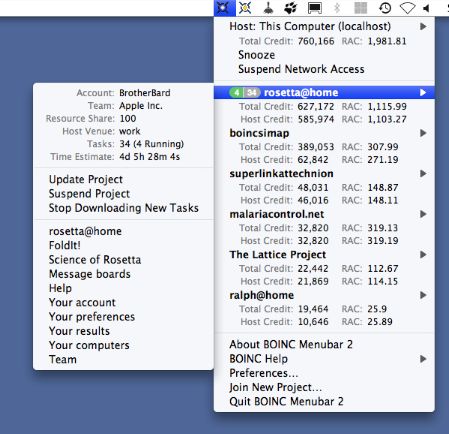

Each year, an international BOINC Workshop is hosted to increase collaboration among project administrators. There are also, however, BOINC projects not included on the official list. In 2009, deployed multi-threaded CPU applications for the first time, followed by the first OpenCL application in 2010.Īs of 15 August 2022, there are 33 projects on the official list. The first BOINC-based project was launched on June 9, 2004.

The BOINC project started in February 2002, and its first version was released on April 10, 2002.

BOINC was designed, in part, to combat these security breaches. As a result, some participants in the project attempted to cheat the project to gain "credits", while others submitted entirely falsified work.
#BOINC GITHUB SOFTWARE#
The original SETI client was a non-BOINC software exclusively for It was one of the first volunteer computing projects, and not designed with a high level of security. BOINC is free software released under the terms of the GNU Lesser General Public License (LGPL).īOINC was originally developed to manage the project.
#BOINC GITHUB CODE#
īOINC code runs on various operating systems, including Microsoft Windows, macOS, Android, Linux, and FreeBSD. Guinness World Records ranks BOINC as the largest computing grid in the world. The National Science Foundation (NSF) funds BOINC through awards SCI/0221529, SCI/0438443 and SCI/0721124. Anderson, who also led As a high-performance volunteer computing platform, BOINC brings together 34,236 active participants employing 136,341 active computers (hosts) worldwide, processing daily on average 20.164 PetaFLOPS as of 16 November 2021 (it would be the 21st largest processing capability in the world compared with an individual supercomputer). The purpose of BOINC is to enable researchers to utilize processing resources of personal computers and other devices around the world.īOINC development began with a group based at the Space Sciences Laboratory (SSL) at the University of California, Berkeley, and led by David P. Developed originally to support it became the platform for many other applications in areas as diverse as medicine, molecular biology, mathematics, linguistics, climatology, environmental science, and astrophysics, among others. This is password for BOINC manager, use anything you likeĮnter 127.0.0.The Berkeley Open Infrastructure for Network Computing ( BOINC, pronounced / b ɔɪ ŋ k/ – rhymes with "oink" ) is an open-source middleware system for volunteer computing (a type of distributed computing).

Sudo /usr/local/etc/init.d/boinc-client stop Sudo /usr/local/etc/init.d/boinc-client start configure -disable-server -disable-manager -enable-optimize Git checkout tags/client_release/7.16/7.16.6
#BOINC GITHUB INSTALL#
Sudo apt install git build-essential pkg-config libsqlite3-dev libssl-dev libcurl4-openssl-dev m4 dh-autoreconf zlib1g-dev python-setuptools I have not verified which is actually faster but crude logic would make me think Native is but? Maybe someone can test that out for me? Just to actually explain what Native is this is to setup up your Linux install to run the project tasks directly on the OS rather than in a VirtualBox VM. There's a few version number updates that need to be made since this guide was written and extra packages, I'm just going to post all the commands with no explanations to them so go to the original source if you want to know more.


 0 kommentar(er)
0 kommentar(er)
